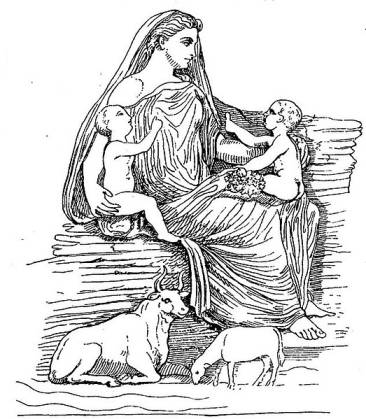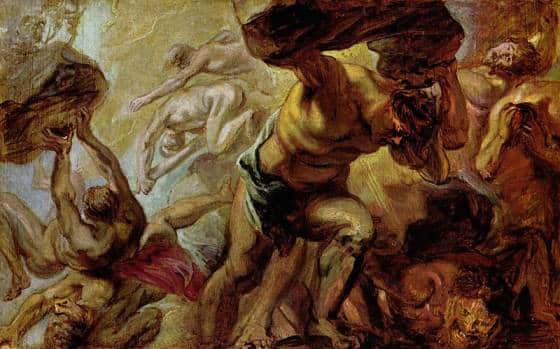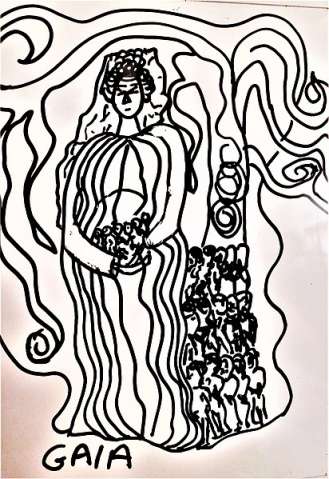Gaia was the Greek goddess of the earth. One of the protogenoi (first-born deities), she was considered to be the creator of all life. Gaia was the first entity that came after Chaos. Wide, beautiful and strong, Gaia gave birth to Uranus (Sky), the Ourea (Mountains) and Pontus (Sea).
She later mated with Uranus and brought forth the Cyclopes, One-Eyed Giant Monsters, the Hecatoncheires and the strong Titans. Gaia orchestrated Uranus’ deposition, aided her grandson Zeus against his cruel father Cronus, and in the end turned against the Olympians. Her symbols are the earth, fruit and grain.
Key Facts
Family tree
| Parents | None (appeared from within Chaos) |
| Partner(s) | Uranus, Pontus, Aether, Tartarus, Poseidon, and Zeus |
| Siblings | None |
| Offspring | First-born: Uranus, the Ourea, and Pontus Titans: Coeus, Crius, Cronus, Hyperion, Iapetus, Mnemosyne, Oceanus, Rhea, Phoebe, Tethys, Theia, and Themis Cyclopes: Arges, Brontes, and Steropes Hecatoncheires: Briareus, Cottus, and Gyges Sea-deities: Ceto, Eurybia, Nereus, Phorcys, and Thaumas Erinyes, Giants, and Meliads Antaeus, son of Poseidon, Orion, The Celestial Hunter, Python, The Ancient Serpent, Tityus, Ophiotaurus, and Typhon, a monstrous serpentine giant |
Names & Others
| Roman Name | Terra, Tellus |
| Other Names | Chthon, Gaea, Ge |
| Ancient Greek | Γαία |
| The Goddess of | Earth, ground, harvest, land, and (all) life |
| Symbols | Earth, female symbol, fruit, grain, and soil |
Gaia’s Origins
In the beginning, there was nothing, an unfathomable void that was neither life nor death. Then came Chaos (Chasm), and soon afterwards the wide-bosomed Gaia (Earth) emerged, everlasting and bountiful. Gaia, deeming it wise to have an equal to herself, gave birth to Uranus (Sky) to love and to hold her on every side.
From her as well came the Ourea (Mountains) and Pontus (Sea). In other sources, Gaia, Uranus and Pontus are the children of Aether and Hemera (Day). The Orphic texts, in particular, mention that Gaia and Uranus are the offspring of Phanes, an obscure first-born deity, and Nyx (Night).
Gaia and her first offspring

Monsters and Titans
With Uranus by her side, Gaia became his consort. She had eighteen children with the god Heaven – three different races of divine beings. Those were the Cyclopes Arges, Brontes, and Steropes (giant creatures with only one eye, but great craftsmen nonetheless); the Hecatoncheires Briareus, Cottus, and Gyges (appalling to behold with one hundred arms and fifty heads each) and last, but not least, the twelve fine Titans Coeus, The Intellectual Pillar of the Celestial North, Crius (Krios), The Pillar of the South, Cronus, Hyperion, The Titan Illuminating, Iapetus, Mnemosyne, Oceanus, Rhea, Phoebe, The Luminous Titaness, Tethys, Theia, The Shining Titaness of Light, and Themis, the goddess of divine law.
Gaia loved all of her children very much, and never, not even once, discriminated against them. Uranus on the other hand wasn’t very fond of the Cyclopes and the Hecatoncheires. He viewed them as abominable and despised them all the same.
Sparing the better-looking Titans, Uranus tossed his children deep down into the earth and locked them there. Yet, Gaia couldn’t put up with this for long. Her pain and agony for her imprisoned offspring inside her body caused her to quickly take action against the tyrant god Sky.
Gaia’s scheme
Secretly creating a very sharp adamantine sickle, Gaia called for the Titans to come to her in one of her deepest caves. Once all of the twelve Titans were there, Gaia showed them the sickle and told them her plan. While four of them would hold Uranus down to the ground another one would use the newfound blade against him.
At first, no one was brave enough to accept this task until Cronus, the youngest among them, boldly stepped up and grabbed the sickle. ‘I will do it!’ he said with sheer determination sparkling in his eyes.
And this is how it was done. Uranus lay down with Gaia, but he couldn’t see his children waiting in ambush, hidden under his wife’s dark lands. Without warning, the Titans jumped on him and immobilized him on the ground while Cronus approached with the adamantine sickle in his hands. With one strike Cronus castrated Uranus and forever deprived him of his power and rule in the cosmos.
After Uranus’ deposition, Cronus and the rest of the Titans set the Cyclopes and the Hecatoncheires free, much to their mother’s delight. Cronus became the new ruler of the world and everything seemed to be going well for a while. Gaia even gave birth to three new groups of extraordinary beings.
With the blood of Uranus dripping on the earth, Gaia produced the chthonic female deities of vengeance called Erinyes, The Goddesses of Revenge And Retribution, the violent Giants, and the beautiful tree Nymphs, Guardians of Nature Meliads.
Gaia protecting Zeus
Unfortunately, as time progressed, Cronus didn’t prove to be a better monarch than his father. He became greedy and fearful of the stability of his dominion. Gaia failed to notice this in time as she fell in love with Pontus and bore his children, the sea deities Ceto, Eurybia, Nereus, Phorcys, and Thaumas.
Gaia was soon joined by her former partner Uranus in order to talk some sense into Cronus. The two primordial gods warn their son that if he didn’t change course he would be destined to fall by his own children.
It is true that Cronus grew mad when he heard his parents’ prophecy. His wife Rhea (also his sister) tried to save him from the dark abyss he had dived into but to no avail. His insanity reached its peak when he started devouring his children right after their birth. Cronus ate five of his offspring before Rhea sought counsel from Gaia and Uranus.
To save her last child, Gaia instructed Rhea on what to do. She gave her daughter a rock the size of her newborn baby boy and wrapped it in cloth. She gave it to her and told her to present it to Cronus saying that it was her child. The ploy worked as the mad Titan swallowed the boulder believing it was his son.
Gaia then took the baby boy away and hid it in a cave in Crete where she secretly raised him. Presently, the boy became a fine and strong man, and under the instructions of his grandmother sought to take vengeance. His name was Zeus.
Titanomachy

Gaia held an important role in the upbringing of Zeus and the establishment of the Olympians. It was the ancestral mother that sent Zeus disguised as a servant to his father’s court. It was her who provided the young god with the poison that would free his siblings from Cronus’ stomach. Zeus acted accordingly to Gaia’s plan and succeeded in rescuing the Olympians. The unsuspicious Cronus drank the poison and immediately started purging one after another of the gods Demeter, Hades, Hera, Hestia, the virgin goddess of the hearth, and Poseidon.
The outcome of this liberation was an all-out war between the new generation of gods and the Titans. Zeus and his siblings were called the Olympians because they chose Mount Olympus as their base of operations and also to be their sacred habitat.
The conflicts that followed were ruthless and seemed to draw on forever. Zeus and the rest of the Olympians couldn’t defeat the Titans. Peace was becoming a dream with each passing day until Gaia gave Zeus the key to victory.
In his madness and thoughtlessness because he was afraid he would be dethroned, Cronus had imprisoned the Cyclopes and the Hecatoncheires in the deepest part of the earth, which was called Tartarus. Gaia was rightfully angered by this and after the war had broken out she grabbed the opportunity presented to her.
She told Zeus to free her children and form an alliance with them. Zeus did so, and with the Cyclopes and the Hecatoncheires by his side, he finally won the war against the Titans and ended the reign of Cronus for good.
Gigantomachy
After his victory, Zeus began his wise rule over the world. But, no sooner had he sat on his throne at Mount Olympus than Mother Earth turned against him. The reason for Gaia’s hostility towards the king of the gods was the same as the previous ones. Zeus had imprisoned his father Cronus and the rest of the Titans in Tartarus, in the deep bosom of the Earth.
Gaia felt betrayed by this act and promptly sent for her children – the giants – to come and wage war against the Olympians. Thus the second great confrontation in the Greek Mythos was called Gigantomachy. The gods and the giants fought many hard and bloody battles during which Gaia learned that the giants could only be killed with the help of a mortal.
The Earth goddess tried to protect her children from this threat but failed the moment the great demigod hero Heracles, The Strongest Hero joined the Olympians and sealed the end of the war. Before long, Zeus and his siblings emerged victorious once again. Gaia however hadn’t said her last word.
Typhon
Not accepting her defeat, Gaia retreated to Tartarus and after mating with him (as Tartarus was both a god and a place), she gave birth to Typhon. Typhon was a hideous and formidable fire-breathing dragon said to be the father of all monsters to come into the world. As Gaia’s most powerful offspring, Typhon attacked Mount Olympus and nearly killed all of the gods.
Even Zeus couldn’t withstand the might of this ferocious dragon. But, when everything seemed lost, the king of the gods rose above the challenge and vanquished Typhon.
Games with Gaia
Test your knowledge about Gaia and other primordial gods of Ancient Greece with this fun quiz:
Don’t forget to try out our other games as well! For example, this game – where you can find out which Greek god or goddess you are!
Other myths about Gaia
After Typhon’s death, Gaia accepted Zeus as the supreme sovereign of the world and bowed her head to him. She never again defied the king of the gods and proved her loyalty to him on many various occasions. Furthermore, Gaia appeared in quite a few myths assisting or punishing gods and mortals.
According to these stories, Gaia gave birth to Erichthonius of Athens after Hephaestus attempted to rape Athena, the goddess of wisdom. Gaia and Tartarus, apart from Typhon, also had Echidna, The Mother of Monstrous, the mother of all the monsters of Greek mythology.
In other tales, Gaia mated with Poseidon and brought forth the brutal half-giant Antaeus, killed Orion for his insolence with a giant scorpion, created the Centaurs, The Half-Human, Half-Horse Beings, transformed an Oread nymph named Pitys into a pine tree, and made Aristaeus immortal.
Gaia’s progeny
Gaia was the great mother of all creatures, practically everything below and above ground. She had many children (gods, titans, giants etc.) with many different partners, and some even by herself alone. Regarding the various myths about her, it’s not easy to list all of them from the oldest to the youngest. Therefore the names mentioned below are in alphabetical order.
Gaia’s offspring: Aergia (goddess), Alcyoneus (giant), Alpos (giant), Anax (mortal man), Antaeus (half-giant), Arges (Cyclops), Briareus (Hecatoncheir), Brontes (Cyclops), Ceto (sea goddess), Charybdis, The Whirlpool Monster (sea monster), Coeus (Titan), Cottus (Hecatoncheir), Creusa (Naiad), Crius (Titan), Cronus (Titan), Damasen (giant), Damysus (giant), Dione (goddess), Dolos (spirit), Echidna (female monster), Enceladus (giant), Erichthonius of Athens (mortal man), Erinyes (deities), Eurybia (sea goddess), Gyges (Hecatoncheir), Hyperion (Titan), Iapetus (Titan), Laestrygon (unknown), Lyssa, The Goddess of Rage and Frenzy, Manes of Lydia (mortal man), the Meliads, Mimas (giant), Mnemosyne (Titaness), Nereus (sea god), Oceanus (Titan), Orion (giant), the Ourea (primordial deity), Palaechthon (mortal man), Pallas (giant), Pheme (spirit), Phoebe (Titaness), Phorcys (sea god), Picolous (giant), Polybotes (giant), Pontus (primordial deity), Porphyrion (giant), Python (serpentine monster), Rhea (Titaness), Steropes (Cyclops), Syceus (Titan), Tartarus (primordial deity), Tethys (Titaness), Thaumas (sea god), Theia (Titaness), Themis (Titaness), Tityus (giant) Triptolemus (mortal man), Typhon (serpentine monster giant), and Uranus (primordial deity)
Etymology
The name Gaia is derived from the word Ge (Γη) with other similar forms like Ga (Γα) and Da (Δα), all meaning Earth. The source of the word is unknown pointing towards a far more ancient origin.
Roles and Responsibilities
As the first-born deity according to Hesiod, Gaia was a very powerful entity in Greek mythology. She presided over everything on (her) earth. As a result, agriculture, crops, fertility, fruits, grain, harvest, land and soil were Gaia’s to give and command.
But not only that, but Gaia ruled the underground realm as well. Chasms, deep caverns, volcanoes, and darkness of the ground are associated with Gaia, who has more than one aspect as does the earth in general.
Gaia’s symbols and worship

In pottery and arts, Gaia appears as a matron with half of her body on the ground or lying on the earth. Her symbols are fruit, grain, land, soil, the mother symbol, and the woman symbol. Earth goddess’ worship wasn’t as popular as that of Zeus’ or the other Olympians. Nonetheless, she was revered as the first primordial deity – creator of all life – and the supreme chthonic goddess of the ancient world.
Her association with the underworld made the people sacrifice only black animals to her. Gaia was called upon to safeguard oaths and protect the souls of the departed. Before Apollo found his temple at Delphi he had to overcome the obstacle of the great serpent Python who was Gaia’s son.
Delphi was believed to be the center of the world and a place of great power for Mother Earth. Moreover, Gaia had many sacred sites dedicated to her in cities such as Athens, Sparta, Olympia and Patra.
In the old texts
Greek
In Hesiod’s Theogony, Gaia comes after Chaos and creates the world.
In the Orphic texts, Gaia and Uranus are the children of Nyx (Night) and the first-born god Phanes.
Gaia is mentioned in Titanomachy and in Hesiod’s lost poem Astronomia.
Pindar, Apollodorus and Euripides refer to the great mother of all, Gaia.
Gaia appears in Homer’s Iliad and Odyssey, as well as in Pausanias’ works and in the tragedian Aeschylus’ work titled ‘Eumenides’.
Roman
The goddess Terra Mater (Mother Earth – Gaia) is attested in Ovid’s Metamorphoses, in Virgil’s Aeneid, and in Hyginus and Nonnus’ works.
FAQs
Gaia was/is Mother Earth. The multi-layered soil people are living and dying upon. She is the most powerful of the divine beings, the first-born and the pre-eminent primordial and chthonic deity. Zeus may be stronger than Gaia, but his authority is void in the absence of Mother Earth.
It wasn’t Gaia who betrayed Uranus but the other way around. Uranus is the one who committed treason when he locked up Gaia’s children in her belly. Gaia is not a prison, but a place of life, peace and prosperity. Therefore, she doesn’t really have a choice but to turn against her husband and depose him.
The same happens with Cronus and later on with Zeus who both don’t respect her and imprison their defeated enemies inside her. So, Gaia’s actions cannot be viewed as unfaithful deeds but as rightful and fair reactions.
How else would Gaia bear the description of Mother Earth if not by birthing so many beings? Gaia is the ancestral and most sacred mother of all life. The myth wouldn’t stand if she was childless or a sworn virgin like the goddess of wisdom, Athena.
Featured Image Credit: Sailko, CC BY-SA 3.0, via Wikimedia Commons
